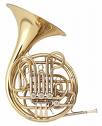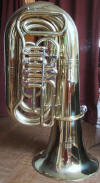















Bugles and Other Brass Instruments
The bugle is the basic instrument which forms all the other brass instruments. While there may be some quibbling of the exact definition , for our purposes a bugle is:
An instrument made of brass or similar metal.
The bugle is manufactured in different keys based on the length of the tubing. For example, in the Scoutbugle.com collection we have the Gunga Din Bugle which plays in the key of "C" this means it plays in a "concert" key, the same as a piano and flute. The Cavalry bugle plays in B-Flat. That means when it plays it's own music and the player plays a "C" it would be the same as a piano playing B flat. This means that the B - Flat trumpet is LONGER then the C trumpet. It naturally plays B Flat. Our Replicas of the original scout bugle has a slide which allows it to play in the key of "G" (pushed in) or "F" (pulled out) It also plays in the key of F sharp, but no-one seems to care about that.
The Natural Bugle Scale

The other brass instruments have at least 3 valves. Some have 4 and 5 which helps with intonation or helping in getting the exact pitch of a note. The valves allow the instrument to play a "Chromatic" scale. This consists of all notes and half steps of a scale. You can think of the half steps as sharps, up a 1/2 step, or flat down a 1/2 step There is one other fly in the ointment. There is only half a step between "B" and "C " and between "E" and "F" which is why the piano black keys have gaps. The first valve adds a full step, the 2nd valve adds 1/2 step and the 3rd valve adds 1 1/2 steps. A 4th valve (if on the instrument) usually adds 2 1/2 steps. You can think of the combination of valves creating different bugles in one instrument.
Chromatic Scale and Valve Fingering

This website disagrees with the Boy Scout Merit Badge book which says there are 8 combinations of valves (thus forming 8 bugles) However the 1-2 combination roughly equals the 3rd valve alone. So the combinations are (Open), (2), (1), (1-2 or 3), (2-3), (1-3), (1-2-3) forming only 7 combinations. PLAY CHROMATIC SCALE
The valved brass instruments come in a great variety based on their key, their octave (one whole scale below or above the other instruments.
The Piccolo Trumpet This instrument is pitched one octave above a regular trumpet usually in B Flat. It's used in some classical music, but is a very difficult horn to play and rather rare. This is a 4 valve version which helps with intonation.
B-Flat Trumpet The B-Flat trumpet is the most popular key of the trumpet. Orchestras often use a "C" trumpet. The can also be found in several other keys. This instrument is used in multiple musical styles from jazz to orchestras. Note for scouts: On page 17 of the Music and Bugling Merit Badge book, the instrument tagged as a trumpet is actually a cornet.
Flugelhorn The
flugelhorn is in the same key as the trumpet but has a darker sound due to its
shape. It's also in the key of B-flat. The flugelhorn is often used
in jazz bands as an alternate instrument for the trumpet player.
Cornet The
cornet plays very much like a trumpet. It's not quite as bright as a
trumpet. It's often used in older style bands such as those playing old
marching tunes or in Dixieland bands.
Pocket
Trumpet A pocket trumpet plays in the same key and octave as the regular
trumpet, it's just, well, more compressed. Not considered a general
performance instrument, but played where the size may come in handy.
 French Horn The French Horn takes us down about 2 1/2 steps to the key
of "F" The French horn is unique among the brass family. It's played
with the left hand. The flared bell makes for a unique sound. The
players right hand is stuck in the bell to change the tone of the horn. A
very hard instrument to play due to the difficulty landing on the right note,
even the professional can crunch a note once in a while.
French Horn The French Horn takes us down about 2 1/2 steps to the key
of "F" The French horn is unique among the brass family. It's played
with the left hand. The flared bell makes for a unique sound. The
players right hand is stuck in the bell to change the tone of the horn. A
very hard instrument to play due to the difficulty landing on the right note,
even the professional can crunch a note once in a while.
Trombone
The trombone drops us an Octave from the trumpet. Unlike the other
instruments seen here, the trombone changes it's pitch by moving a slide to
lengthen or shorten the tubing.
Valve
Trombone The valve trombone differs from the standard trombone in that the
slide is replaced by valves. Not generally used in performance, but has
seen use by jazz great Maynard Ferguson
Baritone
and Euphonium These instruments are usually in the key of B flat. They
are in the same key as the trombone. While the name is used
interchangeably, there is a difference between these two types of horns, a
euphonium is pictured. They usually have 3 or 4 valves.
 The
TUBA The tuba is the bass of the band. It comes in multiple
styles depending on the use. For marching bands there is a version that
even wraps around a player to make marching and playing easier. The tuba
is pitched roughly one octave below the trombone and baritones, however they can
be found in the key of "F", "B-Flat, and "C." The tuba may come in 3, 4 or
5 valves to help with intonation. (Picture used with permission from
www.tuba.com)
The
TUBA The tuba is the bass of the band. It comes in multiple
styles depending on the use. For marching bands there is a version that
even wraps around a player to make marching and playing easier. The tuba
is pitched roughly one octave below the trombone and baritones, however they can
be found in the key of "F", "B-Flat, and "C." The tuba may come in 3, 4 or
5 valves to help with intonation. (Picture used with permission from
www.tuba.com)
Please send comments, etc to: support
Copyright www.ScoutBugle.com 2004 --20013